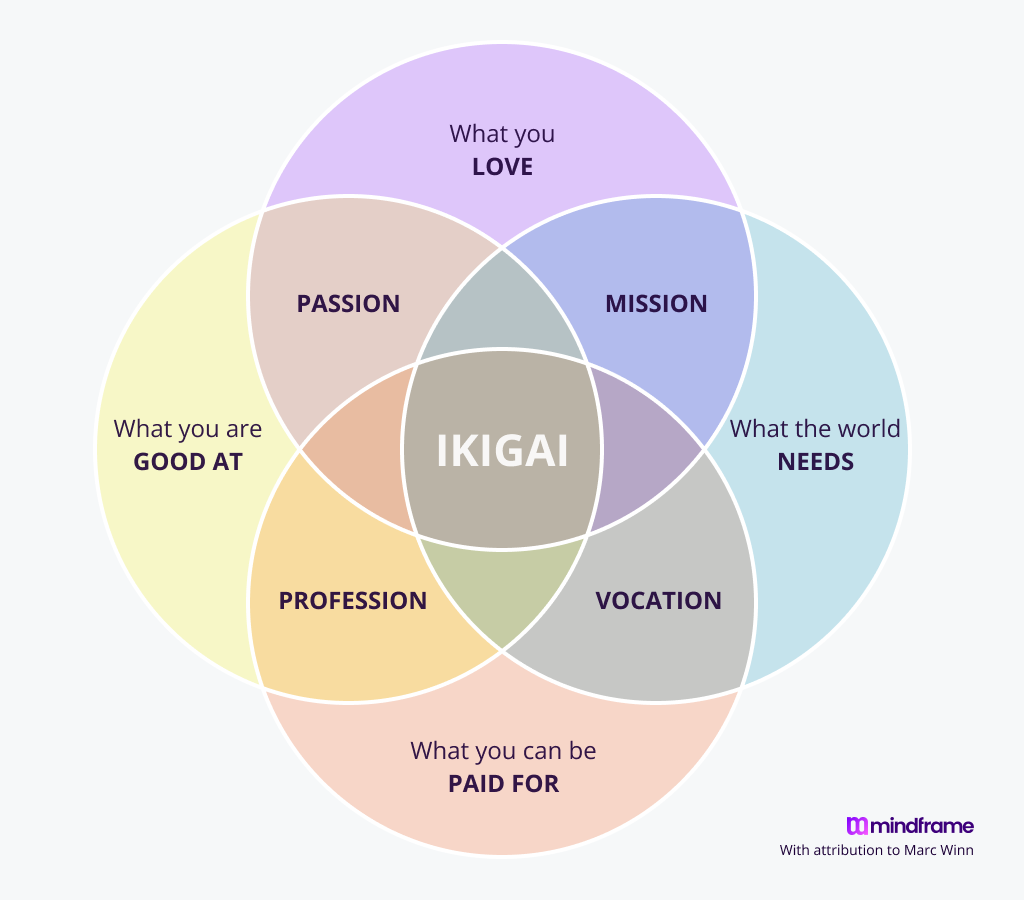Finding happiness is your responsibility. Don’t just expect to fall in love with your work one day. Your employer can’t force you to feel happy at work, either.
I don’t know what makes you happy (bummer – I know). But most people would agree it has to do with being seen and heard and liking your co-workers. In addition, research tells us that feeling engaged and self-fulfilled is a big part of being happy at work.
No one, including you, can force being engaged and finding purpose. But, ta-da, I believe some frameworks can help. Some of my favorites help you discover a reason to get up in the mornings (Ikigai), stay intensely focused (Flow), and reduce daily frustrations (Lingchi).
Feeling Ikigai
Ikigai (“ee-kee-Guy”) is a Japanese term that loosely translates to “reason to live.” It became (inaccurately) popularized in the West as a life philosophy from Okinawa that leads to a longer life.
Conversely to the Western idea of the meaning, Ikigai doesn’t have to be a profound feeling to the Japanese. It can be felt during simple things like spending time with family, playing with a pet, or being deeply engaged in an activity.
In the West, Ikigai is often depicted as a Venn diagram. The diagram became famous when entrepreneur Marc Winn merged Ikigai with astronomer Andrés Zuzunaga’s Venn Diagram of Purpose.

While the diagram is not authentically Japanese, I believe the Ikigai diagram can help you find your purpose or passion at work.
The ikigai diagram is a visual representation of the idea that one’s reason for being can be found at the intersection of four elements: what you love, what you are good at, what the world needs, and what you can be paid for. The idea is that the sweet spot in the center of the intersection represents your ikigai.
So, put on your ikigai-glasses as you examine your professional life. Are there elements that are lacking? What elements are present? Are there ways you could balance each of them?
It may reveal itself to you slowly. In my case, it took me years until the pieces started falling into place, and I started discovering things I could do to feel Ikigai.
Still, don’t make the mistake of expecting you can feel Ikigai at all times. Chasing after an impossible dream might make you unhappy in the process.
Getting Into Flow
You’ve probably heard of psychologist Mihaly Csikszentmihalyi‘s Flow. Flow is a state of mind in which you become fully immersed in an activity.
Remind yourself what it felt like when you were “lost in the moment,” and tell me you don’t want to feel like that all the time. In fact, research tells us that there is a link between Flow and happiness. That’s why one of my goals is to spend more time on activities that get me into Flow.
So, what can you do to get into Flow? Here are a few common tips:
Choose an activity that you find challenging but not too difficult. The activity should be something you enjoy and are motivated to do.
Set clear goals and objectives for the activity. A clear idea of what you want to accomplish will help you focus and stay on track.
Remove distractions. Find a quiet place where you can work without interruptions. Turn off your phone and other devices, and let others know you do not want to be disturbed.
Get into the right mindset. Relax and clear your mind of any negative thoughts or worries. Focus on the present moment and your activity.
Get into the right physical state. Make sure you are comfortable and have everything you need. Take breaks as needed to stretch or rest.
Start working on the activity. Pay attention to your progress and the task at hand as you work. If you make a mistake, don’t get discouraged – instead, learn from it and move on.
Stay focused. It’s natural to get distracted sometimes, but try to bring your attention back to the task as quickly as possible.
Avoiding Lingchi
You might know Lingchi as “death by a thousand cuts.” Originally an ancient Chinese form of executing, it is used today as a metaphor for the minor daily frustrations that compound into infuriating problems.
Your frustrations accumulate throughout your day as you sit in traffic, deal with other people, technology, and so on. And eventually, they get a stranglehold on your mental health and psychological well-being.
Imagine how you felt if all the little frustrations faded? I bet you’d be happy at work.
First, identify your frustrations. Check in with yourself at the end of the day or week and ask yourself what situations frustrated you and what went wrong.
Then, think about what can you do differently? Can you achieve the same goal in another way? Can you change how you react to other people’s actions or words?
Specifically, think about what triggers the frustration. See if you can remove the trigger or change your behavior.
I recommend writing down rules on how you want to react or what you will do differently next time. It will take some time, but following through helps you create positive habits and reduce frustration over time.
It’s also critical to accept that some things you don’t have control over. So, do your best to put those things behind you. Accepting facts and managing your reaction to things helps increase your frustration tolerance.
Ask for Help To Become Happy at Work
As you journey through to feel Ikigai, get into Flow, and reduce Lingchi, you may need help from your co-workers. So, don’t limit yourself but ask others to support you. Talk to your manager, team, HR, and others and ask them for specific help you need.
Feel free to use a template like this:
“Hi [name], I’ve thought about what I could do to be more effective at work. I’ve noticed that [something you are missing/frustrates you] makes it hard for me to be as engaged as I would like. I can get more done if [your direct ask]. Let me know what you think. Thank you!”
If your manager is any good, they will recognize your critical thinking skills and appreciate that you want to develop professionally. Remember that asking for help is a win-win because being happy at work will make you a better employee.
We spend so much of our lives working that making even small improvements in our professional life goes a long way. So, I hope these frameworks help you discover your professional goals. Just remember to set yourself up for success by creating measurable goals.

